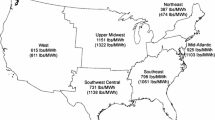Abstract
The role of technology cooperation in international climate policy has drawn considerable attention in recent years. This article examines the possibility that an international agreement to deploy clean energy would pave the way to future climate cooperation. My game-theoretic analysis shows that even if technology deployment produces mostly private benefits for each country, an agreement can increase global pollution abatement efforts. If technology deployment allows countries to credibly commit to pollution abatement through sunk costs, the international community can form two coalitions. One deploys the technology and then abates pollution, whereas the other only abates pollution. A technology deployment agreement is useful and feasible when the total number of concerned countries is high and technology deployment is very costly but effective in reducing the cost of future pollution abatement.
Similar content being viewed by others
Notes
“EU Leaders Reach New Climate Deal.” BBC News December 12, 2008.
The linear payoff structure simplifies exposition, but all key results would continue to hold even if the payoff K was replaced by a value function V(K), where V would be an increasing, but strictly concave function of the number of abaters K.
References
Asheim GB, Froyn CB, Hovi J, Menz FC (2006) Regional versus global cooperation for climate control. J Environ Econ Manag 51(1):93–109
Barrett S (1994) Self-enforcing international environmental agreements. Oxf Econ Pap 46(Supplement):878–894
Barrett S (2001) International cooperation for sale. Eur Econ Rev 45(10):1835–1850
Barrett S (2003) Environment and statecraft: the strategy of environmental treaty-making. Oxford University Press, Oxford
Barrett S (2006) Climate treaties and ‘breakthrough’ technologies. Am Econ Rev 96(2):22–25
Bloch F (1997) Noncooperative models of coalition formation in games with spillovers. In: Carraro C, Siniscalco D (eds) New directions in the economic theory of the environment. Cambridge University Press, Cambridge
Carraro C, Siniscalco D (1993) Strategies for the international protection of the environment. J Public Econ 52(3):309–328
Carraro C, Siniscalco D (1995) R&D cooperation and the stability of international environmental agreements. CEPR discussion paper 1154
de Coninck H, Fischer C, Newell RG, Ueno T (2008) International technology-oriented agreements to address climate change. Energy Policy 36(1):335–356
Gallagher KS, Holdren JP, Sagar AD (2006) Energy-technology innovation. Annu Rev Environ Res 31:193–237
Hoel M, de Zeeuw A (2010) Can a focus on breakthrough technologies improve the performance of international environmental agreements?. Environ Res Econ 47(3):395–406
Jamasb T (2007) Technical change theory and learning curves: patterns of progress in electricity generation technologies. Energy J 28(3):51–71
Nemet GF (2006) Beyond the learning curve: factors influencing cost reductions in photovoltaics. Energy Policy 34(17):3218–3232
REN21. (2013) Renewables Global Futures Report: 2013. Paris: REN21 Secretariat
Sandén Björn A, Azar C (2005) Near-term technology policies for long-term climate targets: economy wide versus technology specific approaches. Energy Policy 33(12):1557–1576
Söderholm P, Sundqvist T (2007) Empirical challenges in the use of learning curves for assessing the economic prospects of renewable energy technologies. Renew Energy 32(15):2559–2578
Stern N (2006) The economics of climate change: the Stern review. Cambridge University Press, Cambridge
Unruh GC (2000) Understanding carbon lock-in. Energy Policy 28(12):817–830
Acknowledgments
I thank the editor of Environmental Economics and Policy Studies, two anonymous reviewers, Scott Barrett, Matthew Kotchen, and the conference participants for detailed comments and advice.
Author information
Authors and Affiliations
Corresponding author
Additional information
Previous draft of this manuscript was presented at the 2011 Yale Conference on International Environmental Agreements.
Mathematical appendix: optimality of deployment
Mathematical appendix: optimality of deployment
Suppose \(\overline{c}+1>\underline{c}+c^{D}\). Consider the deployment participation stage and examine the external stability of any coalition. If the coalition has fewer than L members, it is clearly irrelevant because they will not deploy even together. This case can be ignored. If the coalition has more than L members, internal stability is clearly violated, as shown in the main text.
Suppose now that the coalition has L or more members. I show that external stability is violated. To see this, consider a non-member of the deployment coalition that expects to be a member of the K-member abatement coalition at a subsequent stage of the game. Suppose the country, labeled i, changes strategy and joins the deployment coalition instead. The total number of abaters increases from L + K to L + K + 1. At the same time, country i’s own cost changes from \(\underline{c}+c^{D}\) to \(\overline{c}\). This means that external stability is violated whenever \(\overline{c}+1>\underline{c}+c^{D}\).
About this article
Cite this article
Urpelainen, J. Sinking costs to increase participation: technology deployment agreements enhance climate cooperation. Environ Econ Policy Stud 16, 229–240 (2014). https://doi.org/10.1007/s10018-013-0075-5
Received:
Accepted:
Published:
Issue Date:
DOI: https://doi.org/10.1007/s10018-013-0075-5




